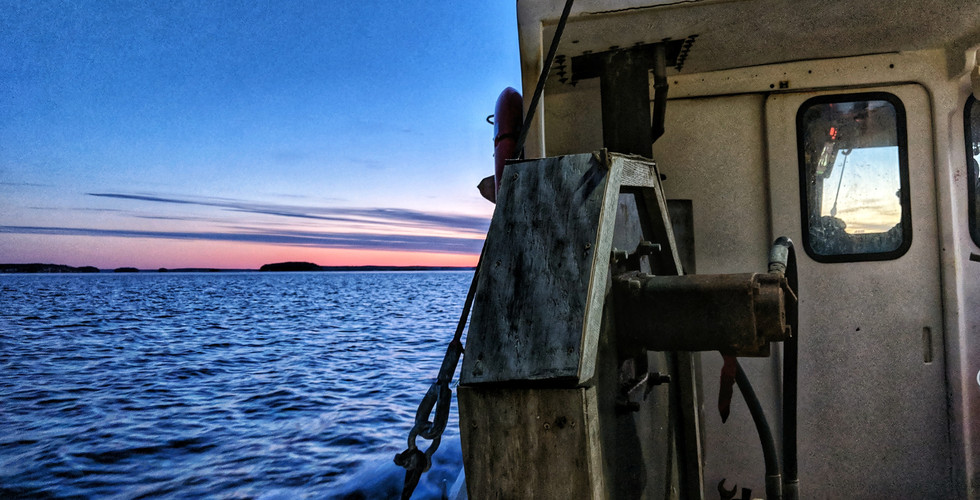
It’s an early 4 a.m. when my alarm goes off. They say the early bird gets the worm, but we're not fishing with worm bait this trip.
I see a light from the Joshua & Jacob steaming towards shore against a blanket of predawn light. I climb aboard the 42 ft vessel from the tall Little John Dock: up and around the wheelhouse, over the narrow side, and down onto the deck of the boat.
I stand entranced watching the sunrise from the back deck; the ice-cold wind on my face. The colors paint the sky with the bright orange sunrise on the purple, pink, and blue sky. The temperature is in the teens and won’t reach 30 degrees for the day.
It’s a short ride to our fishing grounds around Harpswell. Maine State Regulations only permit fishing within 3 miles of the shore. Captain Alex Todd explains some of the regulations that have been put in place to ensure the conservation of the scallop fishery for the future:
In January-March 2019 fishing is only permitted Monday-Thursday (with some date exclusion) from sunrise to sunset within Maine’s territorial waters.
There is a minimum size requirement for Atlantic sea scallops whose shells are 4 inches in longest diameter.
A vessel may possess or land no more than 15 gallons of scallop meats per day.
Restrictions on dredge size and configuration limits the amount of bottom contact when dragging, helping to protect the ocean floor and halibut.
Area closures are imposed as a conservation measures to assist in rebuilding specific areas of the state and fishery.
Alex’s boat will soon be outfitted with cameras as part of a National Fish and Wildlife Foundation grant to support electronic technologies in U.S. Fisheries; an essential component of systems that efficiently meet the information needs of fishery managers, scientists, and fishermen. MCFA has been a key player in a pilot project to determine if Electronic Monitoring (EM) technology can be used to collect information and reporting programs in a more cost-effective and safe manner. This recent grant is allowing us to expand the program to include scallop trips. The hope is to advance EM and reporting tools to improve data accuracy for commercial fisheries.

I stay out of the way for the first few tows. Controlling from the wheelhouse Alex brings the dreg, the large metal ringed net, aboard as the two crew members perform their duties from the deck. It is an impressive display of what looks like a choreographed routine.
The scallops fall onto a small platform on the very back deck. We sort the live scallops discarding any shells or juveniles. A measuring ring hangs from the center net to measure for size.
The scallop shucking takes place as we tow around a small around ranging from 10-20 minutes. I later learn some of the reasoning for this requirement:
As a shellfish, parts of the scallops can contain a biotoxins that can make people ill. Shucking removes the part of the scallop most susceptible to these toxins only leaving the muscle, the part of the scallop we eat. Shucking eliminates the need for toxin testing when the meat is landed.
The United States does not a large market for scallop roe or other pieces of the scallop, so the industry currently does have the proper procedures in place for landing the whole shellfish.
There is also some evidence that shells discarded back in the ocean help provide a good habitat for future generations of young scallops.

Throughout the day I hardly fill a mere 1-gallon bucket to multiple full buckets of the crew. It wasn’t until the final tows that I start to even remotely get the hang of the shucking process. The seagulls follow and swarm behind the boat as we discard the excess meat and shells back into the water.
An unshucked basket of scallops is giving back to the sea as tribute as we filled the allotted 3 x 5-gallon buckets of scallop meat quota for the day. We head back to Cousin’s Island where we meet Touge from Downeast Dayboat. They weigh out bags for Downeast Dayboat scallops already sold and the rest are giving to taken that will immediately be distribute to purchasers.
“You never get a scallop fresher than you do with Maine boats. These scallops today will be in someone’s house tonight. If you get them from other states or trip boats sometimes you have a few days before they even hit the dock. The freshness really makes a difference.” Alex explains.

I myself bought more than my far share knowing that scallops can be frozen. Now when my friends and family come from out of town, we can enjoy Caila-caught-scallops and be able to share my experience all over again.
I’m home before dark. For snack and dinner, I indulge on the most delicious seafood I have ever had. Alex was right, freshness really makes a difference.
I want to say a big thank you to Alex, Josh, and Levi for allowing me to join them for the day. It was an incredible experience that I will never forget.
Maine Coast Fishermen’s Association’s strives to ensure that the next generation of fishermen have the community infrastructure and environmental resources to maintain Maine's coastal cultural identity and sustain vibrant working waterfronts. The Fishermen’s Association is working with Maine scallop fishermen to build a sustainable fishery for this and the next generation of fishermen.



































